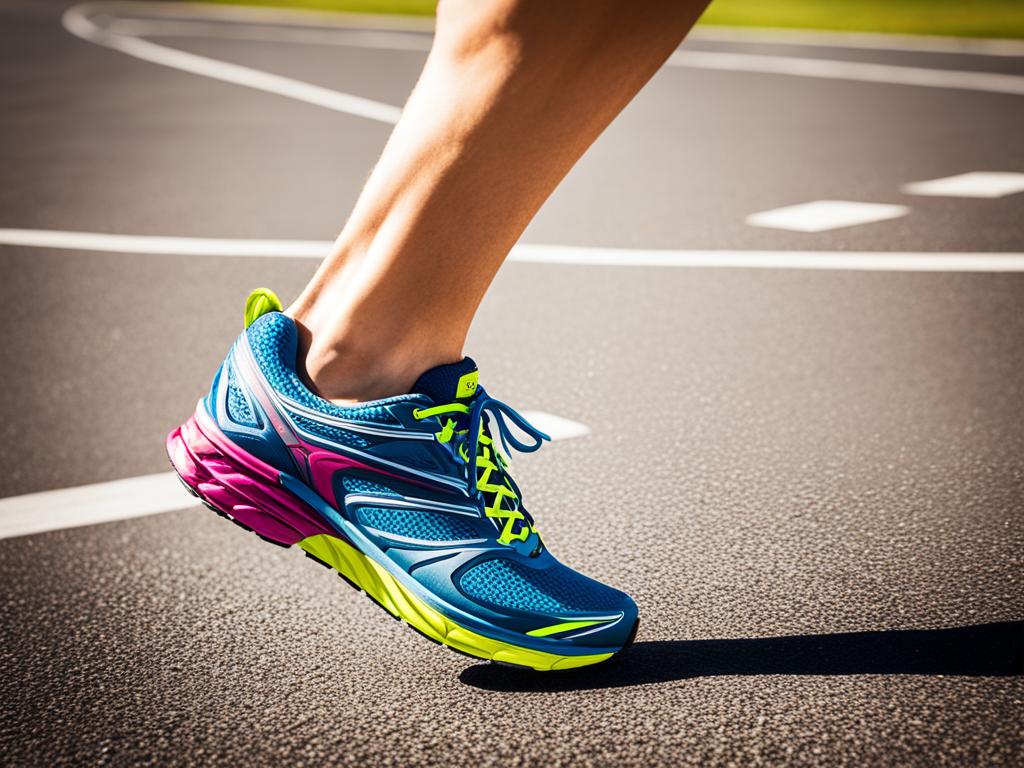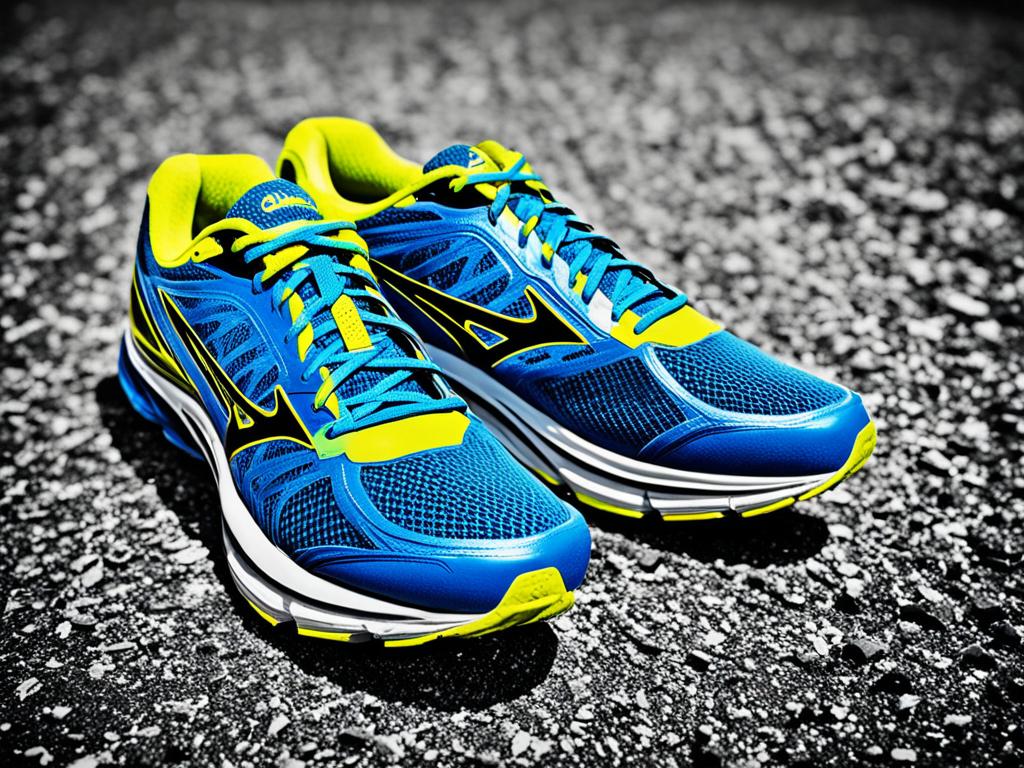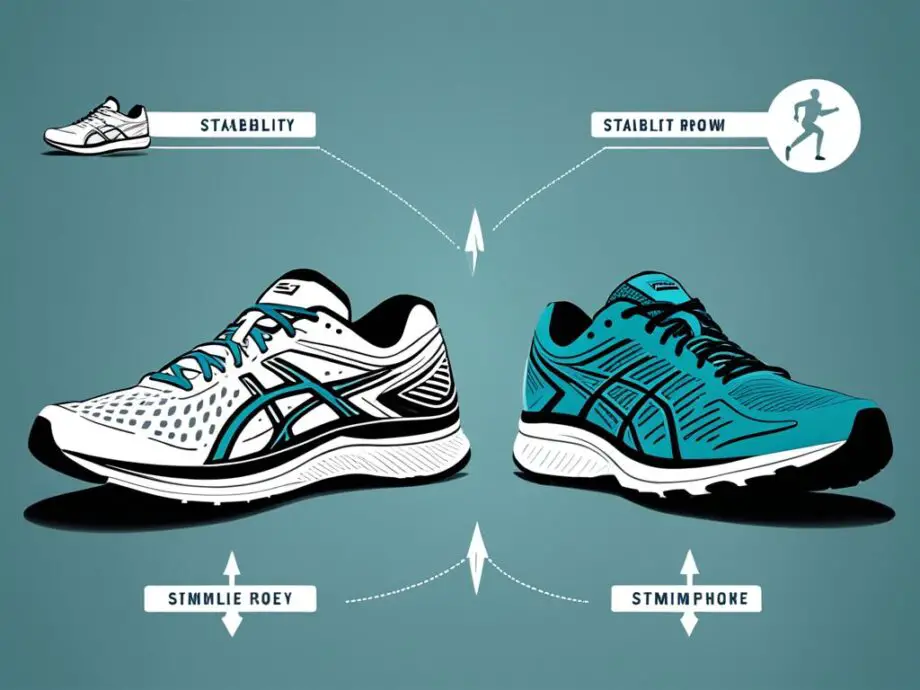When it comes to finding the perfect running shoes, the options can be overwhelming. There are various types of running shoes available, and it’s crucial to understand the differences between them to make an informed decision. Two popular categories of running shoes are neutral and stability shoes. In this article, we will delve into the nuances of neutral vs stability running shoes, helping you choose the right pair for your specific needs.
Key Takeaways:
- Neutral and stability running shoes cater to different types of runners.
- Neutral running shoes provide cushioning and support for runners with a neutral or normal pronation pattern.
- Stability running shoes help control overpronation and prevent common injuries.
- Choosing the right running shoe involves considering factors such as foot type, gait analysis, and pronation pattern.
- The right running shoe can enhance comfort, prevent injuries, and improve performance on the track.
Understanding Neutral Running Shoes
When it comes to finding the perfect running shoe, understanding your individual running style and needs is essential. For runners with a neutral or normal pronation pattern, neutral cushioned running shoes offer the ideal combination of comfort and support.
Neutral running shoes are designed to provide cushioning and shock absorption, allowing for a smooth and comfortable ride. They are particularly beneficial for runners who do not overpronate or underpronate, as they provide the right amount of stability without interfering with the natural movement of the foot.
So, what sets neutral running shoes apart? Let’s take a closer look at some of the key features and benefits:
Optimal Cushioning:
One of the standout features of neutral running shoes is their exceptional cushioning. These shoes are equipped with additional padding and cushioning materials in the midsole and heel areas, providing a soft and responsive feel with every stride. This cushioning helps to absorb impact, reducing stress on the joints and minimizing the risk of injuries.
Lightweight Design:
Neutral running shoes are often made with lightweight materials, allowing for easier and more efficient running. The lighter design promotes agility, enabling runners to maintain a faster pace without feeling weighed down.
Versatility:
Neutral cushioned running shoes are versatile and suitable for a wide range of running activities. Whether you’re hitting the pavement for a long-distance run or tackling the trails, these shoes offer the flexibility and adaptability needed to keep you comfortable and supported throughout your run.
When it comes to support features, neutral running shoes strike a balance between providing stability and allowing for natural foot movement. These shoes typically have a neutral or slightly curved last, which means they do not have excessive arch support or pronation control features.
The combination of optimal cushioning, a lightweight design, and versatility makes neutral running shoes a popular choice among runners who desire a well-balanced shoe that offers comfort and support.
Now that we’ve explored neutral running shoes, it’s time to delve into stability running shoes in the next section. These shoes are specifically designed for runners with pronation issues, providing the necessary support and control to enhance performance and reduce the risk of injuries. Stay tuned!
Exploring Stability Running Shoes
In the world of running, finding the right pair of shoes can make a world of difference in your performance and overall running experience. For runners who require pronation control and additional support, stability running shoes are the go-to choice. Understanding what pronation is and how stability shoes can benefit you is crucial in making an informed decision.
What is Pronation?
Pronation is a natural movement that occurs when your foot rolls inward during the running or walking gait cycle. It helps absorb the shock of each stride and aids in distributing the forces evenly throughout your lower limbs. However, excessive pronation, known as overpronation, can lead to imbalances and increased stress on certain areas of the body, resulting in potential injuries.
Why is Pronation Control Important?
When it comes to choosing running shoes, considering your pronation pattern is essential. Stability running shoes are designed specifically to assist runners with overpronation. These shoes incorporate features that help control and correct pronation, providing a stable and supportive platform for your feet.
Preventing Common Injuries
Stability running shoes offer several benefits that can help prevent common running injuries. By controlling overpronation, these shoes help align your feet and ankles, reducing the risk of plantar fasciitis, shin splints, and knee pain. The supportive features of stability shoes provide stability and cushioning, minimizing the impact on your joints and muscles.
It is important to note that stability shoes are not only beneficial for runners with overpronation but can also be suitable for those with normal pronation who prefer added support and stability.
The Benefits of Stability Running Shoes
Stability running shoes offer a wide range of benefits that can enhance your running experience. Some of the key advantages include:
- Improved stability and balance during your runs
- Enhanced shock absorption for a more comfortable ride
- Reduced risk of injuries by providing proper support
- Increased longevity of your running shoes due to reinforced construction
When combined with a proper fitting and appropriate running technique, stability running shoes can help you reach your running goals while minimizing the risk of injuries.

With pronation control and stability in mind, choosing the right pair of running shoes is crucial for a successful and injury-free running journey. In the next section, we will provide you with practical tips on how to select the perfect running shoe based on your individual needs and running style.
Choosing the Right Running Shoe
When it comes to finding the perfect running shoe, it’s essential to consider your individual needs and requirements. With so many options available, it may feel overwhelming to make the right choice. However, by understanding key factors such as foot type, gait analysis, and pronation pattern, you can narrow down your options and choose a shoe that provides optimal comfort and performance.
Factors to Consider
Foot Type: Every runner has a unique foot shape and structure. It’s important to determine whether you have high arches, low arches, or a neutral arch. By identifying your foot type, you can select a shoe that offers adequate support and stability.
Gait Analysis: Conducting a gait analysis can provide valuable insights into your running mechanics. This analysis evaluates how your feet move while running and helps identify any irregularities or imbalances. Using this information, you can choose a shoe that addresses specific concerns related to your gait.
Pronation Pattern: Pronation refers to the natural inward rolling motion of the foot. Understanding your pronation pattern can guide you in selecting the appropriate shoe category. For neutral runners, who have a balanced pronation, a neutral running shoe is ideal. In contrast, runners with overpronation may benefit from stability shoes that provide additional support and stability.
Tips for Choosing the Right Shoe
- Visit a Running Specialty Store: Consider visiting a specialty running store where experienced staff can assist you in finding the right shoe based on your individual needs. They can conduct a gait analysis, analyze your feet, and recommend the best options for you.
- Try Them On: Always try on multiple pairs of shoes and walk or run around the store to assess their fit and comfort. Remember that running shoes should have ample toe room, a snug heel fit, and provide overall support without causing discomfort or pain.
- Consider Terrain: Think about the type of surface you mostly run on. Different shoes are designed for road running, trail running, or a combination of both. Choose a shoe that suits the terrain you frequent to maximize stability and performance.
- Don’t Forget Socks: When trying on running shoes, wear the type of socks you typically use while running. This ensures a more accurate fit and helps you assess the level of comfort and support the shoe provides.
Remember, choosing the right running shoe is not just about style or brand. It’s about finding the right balance between comfort, support, and performance. By considering factors such as foot type, gait analysis, and pronation pattern, and following these tips, you can confidently select a shoe that suits your individual running needs.

Optimal Comfort and Performance on the Track
When it comes to running, finding the right pair of shoes can make all the difference in terms of comfort and performance on the track. While there are many factors to consider when choosing running shoes, stability is a key aspect that should not be overlooked.
Wearing shoes specifically designed for stability can greatly enhance a runner’s stride and overall experience. These shoes are built to provide the necessary support and control to prevent overpronation, a common issue that can lead to discomfort and injuries.
Not only do stability running shoes offer excellent stability and motion control, but they also provide cushioning and responsiveness to keep you comfortable mile after mile. Their supportive features help maintain proper alignment, reduce fatigue, and minimize the risk of injuries.
So, which are the best running shoes for stability? Here are some top choices:
| Brand | Model | Description |
|---|---|---|
| Nike | Air Zoom Structure | A popular choice among runners, the Air Zoom Structure offers dynamic support and responsive cushioning for a smooth, stable ride. |
| Brooks | Adrenaline GTS | The Adrenaline GTS is known for its reliable stability and comfortable fit, making it a favorite among overpronators. |
| ASICS | GEL-Kayano | With its GEL cushioning system and supportive features, the GEL-Kayano provides exceptional stability and long-lasting comfort. |
No matter which brand or model you choose, it’s important to try on different options and consider factors such as your foot type, pronation pattern, and personal preferences. Remember, finding the perfect pair of stability running shoes will greatly contribute to your overall performance and enjoyment on the track.

Conclusion
To ensure a comfortable and injury-free running experience, it is crucial to choose the right type of running shoe. Throughout this article, we have explored the differences between neutral and stability running shoes and highlighted their respective benefits.
Neutral running shoes are designed for runners with a normal pronation pattern, offering cushioning and support without altering the natural foot motion. On the other hand, stability running shoes are recommended for those with overpronation issues, helping to control the inward rolling of the foot and providing the necessary support to prevent injuries.
By understanding your pronation pattern, considering your foot type, and conducting a gait analysis, you can make an informed decision when selecting your next pair of running shoes. Remember, the right running shoe will not only enhance your performance but also promote comfort and reduce the risk of injuries.
So, whether you’re a neutral runner or someone in need of pronation control, take the time to explore the market and find the perfect pair of running shoes that cater to your specific needs. Your feet will thank you for it!
